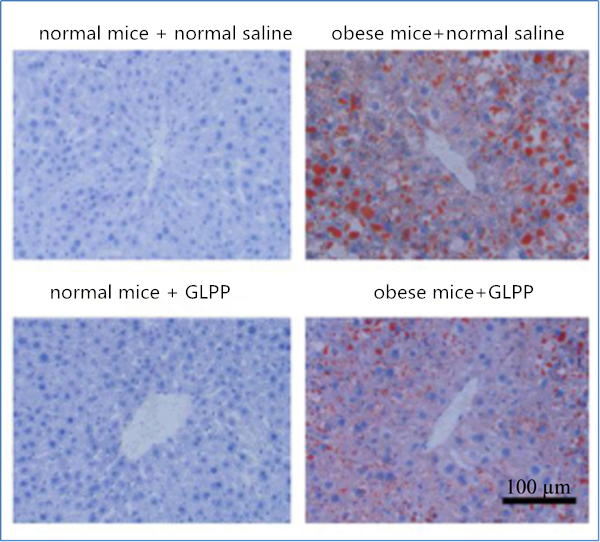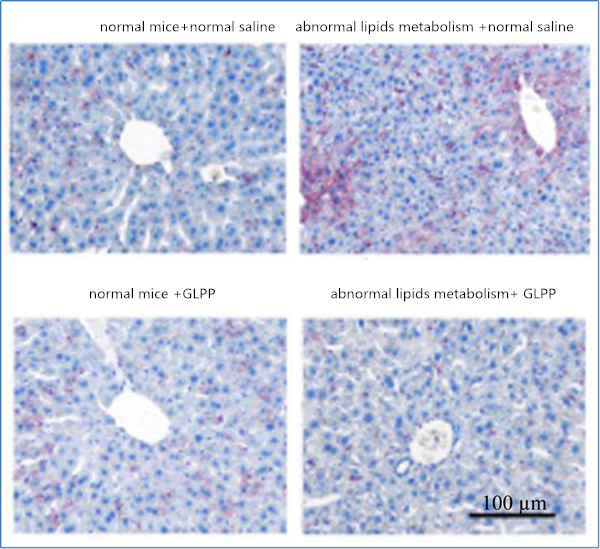Ganoderma Lucidum Polysaccharide Peptide Alleviates Hepatoteatosis
New discovery for the hepatoprotective effect of Ganoderma lucidum
Although excessive alcohol intake is one of the main culprits of fatty liver, when every meal can be satiated and there are snacks between two meals, fatty liver may occur even if the drinks are not touched.
This is because all nutrients absorbed from the intestinal tract must be transported to the liver and converted into a form that the body can use before they are transported to the tissues and cells. Therefore, whether it is excessive calorie intake from the diet or excessive synthesis of triglycerides (fat) in the liver, it may cause fatty liver, which contains more than 5% fat in the liver, or 10% fat accumulation in the liver cells.
Clinically, the most common prescription for the treatment of this kind of “non-alcoholic fatty liver” is diet, exercise and weight loss. If Ganoderma lucidum can be added at this time, it is likely to achieve twice the result with half the effort.
A team led by Professor Yang Baoxue, Department of Pharmacology, Peking University, confirmed that Ganoderma lucidum polysaccharide peptide (Ganoderma lucidum polysaccharide containing 5% protein) in the water extract of Ganoderma lucidum can reduce liver fat accumulation, reduce liver damage, and even help control blood lipids and blood sugar. The research results were published in Cellular Physiology and Biochemistry (Journal of Cellular Physiology and Biochemistry) at the end of 2018.
Yang Baoxue’s team adopted two experimental animal models:
One is obese mice lacking leptin gene, which have strong appetite and fast weight gain. In addition to fatty liver, they also have metabolic abnormalities such as insulin resistance, hyperglycemia and hyperlipidemia.
The other is the mice with abnormal lipid metabolism transfected with human APOC3 gene, which causes abnormal lipid metabolism in the liver and excessive synthesis of triglycerides, leading to abnormal fatty liver and lipid.
The mice were fed 100 mg/kg of Ganoderma lucidum polysaccharide peptide daily without restriction on food and drinking water. After one month, the mice were compared with the same type of mice without Ganoderma lucidum polysaccharide peptide and normal mice (both groups with and without Ganoderma lucidum polysaccharide peptide). The mice without Ganoderma lucidum were replaced by the same amount of normal saline.
The results were as shown in Fig. 1 and Fig. 2. The red part represented the oil droplets in the cells. Obviously, eating Ganoderma lucidum polysaccharide peptide for a month alone can reduce fat accumulation in the liver.

Flag 1 A month later, fat distribution (red part) in liver tissue of obese mice and normal mice was compared.

flag2A month later, fat distribution (red part) in liver tissue of obese mice and normal mice was compared.
Result 1: Liver protection–Less fat accumulation, better lipid metabolism, lower inflammatory index and lower insulin resistance
Further presenting the experimental results with specific data, we can see that no matter obese mice or mice with abnormal lipid metabolism, those who eat Ganoderma lucidum polysaccharide peptide:
Lipid accumulation in the liver is less, lipid metabolism in the liver is better, and hepatitis index AST and ALT increase slightly, which means that hepatocytes are less damaged and the sensitivity of hepatocytes to insulin is close to normal.
What is the relationship between “hepatocyte sensitivity to insulin” and “fatty liver”?
Fat accumulation in the liver reduces the sensitivity of hepatocytes to insulin, which is called insulin resistance. The more resistant the hepatocytes are, the harder it is to use (consume) the fat stored in the cells. In turn, insulin resistance also causes the liver to accumulate more fat. The difference of insulin sensitivity-related protein (p-AKT2/AKT) content in hepatocytes of experimental mice shown in Figure 4 shows that Ganoderma lucidum polysaccharide peptide can prevent this vicious cycle.
Result 2: Improve blood lipid
Not only the burden of liver was lightened, but also the degree of dyslipidemia was not so bad in obese mice fed Ganoderma lucidum polysaccharide peptide and mice with abnormal lipid metabolism. Especially in mice with abnormal lipid metabolism, there was a significant difference between the four lipid indices of mice fed Ganoderma lucidum and those without Ganoderma lucidum .
Because the amount of triglycerides and cholesterol in blood lipids is regulated by the liver, when Ganoderma lucidum polysaccharide peptide improves the ability of liver to metabolize lipids, it naturally has a good effect on blood lipids.
Result 3: Improve blood sugar
In addition, the researchers also conducted a glucose tolerance test (GTT) in obese mice with hyperglycemia, i.e. after six hours of fasting, the mice were given a large amount of glucose and monitored the changes of blood sugar concentration in the next two hours.
Results As shown in Fig. 8, obese mice fed Ganoderma lucidum polysaccharide peptide GLPP for one month had relatively low blood sugar values and relatively stable fluctuations. Obviously, Ganoderma lucidum polysaccharide peptide can also improve the utilization of glucose in tissue cells, not only improve hyperglycemia, but also reduce the chance of glucose converting into fat hoarding.
Result 4: Reduce visceral fat accumulation
Visceral fat is closely related to fatty liver, and mesenteric fat is one of the representatives of visceral fat (mesentery refers to the membranous tissue located in the inner wall of the abdominal cavity, covering the intestine, used to fix the large and small intestines).
According to the experimental results of Yang Bao et al., obese mice fed Ganoderma lucidum polysaccharide peptide GLPP for one month had relatively less fat attached to mesentery and smaller size (diameter) of adipocytes (figure 9). It showed that visceral fat accumulation was significantly reduced due to Ganoderma lucidum polysaccharide peptide.
Reference:
1. Zhong D, et al. Ganoderma Lucidum Polysaccharide Peptide Alleviates Hepatoteatosis via Modulating Bile Acid Metabolism Dependent on FXR-SHP/FGF. Cell Physiol Biochem. 2018;49(3):1163-1179.
2. Jung S, et al. Ganoderma lucidum Ameliorates Non-Alcoholic Steatosis by Upregulating Energy Metabolizing Enzymes in the Liver. J Clin Med. 2018, 7(6), 152.







